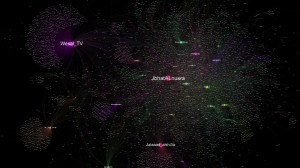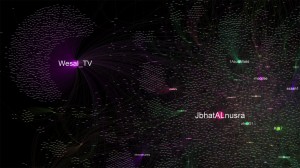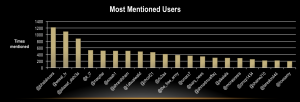For the second installment of our Jihadi Twitter Activism series Ali Fisher and Nico Prucha explore data collected from Twitter related to the Syrian AQ branch Jabhat al-Nusra. This post identifies key ‘influence multipliers’ for Jabhat al-Nusra’s strategic communication and an overview of the content that these multipliers disseminate via Twitter.
To analyze jihadi social media networks, their sympathizers and followers we have used an interdisciplinary approach, which combines big data techniques, network analysis and the subsequent analysis of key users and content. In this post we present preliminary analysis of over 76,000 tweets relating to Jabhat al-Nusra collected over 50 days between January and March 2013.
To measure the dissemination of jihadi content and to gain greater insight into the hubs sharing jihadi propaganda, we measured the most mentioned and most active users. Furthermore, the results, along with calculations to establish the size and structure of the networks, allow us to find those at strategic positions within the networks sharing content relating to Jabhat al-Nusra.
To understand the resonance of jihadi propaganda, we identify and analyze the most shared links and the content to which those links lead. As we show, these links lead predominantly to YouTube clips and pictures. The advantage of using Twitter for link sharing is that the content can often be viewed directly without switching applications or copy and pasting, depending on the users’ Twitter client and device (computer, tablet, smartphone).
The links to YouTube have the dual strength of a rich media environment and the potential to draw the viewer into a densely interconnected cluster of mutually reinforcing video content. In some cases the users must be aware of current jihadi developments and trends to fully comprehend pictures that may appear odd to an uninitiated viewer. However, other videos are a clear and obvious part of the jihadi visual culture of martyrdom and advocate ideological harmony. Pictures of individual martyrs for example, are framed as part of the overall jihadi culture and are popular on Twitter (and Facebook) where they are commemorated and propagated as role models.
By understanding the most mentioned users within a sample, we can measure impact by analyzing who is retweeting jihadi content and who is retweeted. This is even more so relevant, when accounts have a greater number of followers and thus turn into vital hubs of re-dissemination. The most shared links, naturally, indicate what parts of the jihadi propaganda resonate most among its target, as well as ‘collateral’, audience (this will be at the center of our next posting).
The strategic communication of Jabhat al-Nusra
Newer groups, such as Jabhat al-Nusra (JN), have been using Twitter since its establishment in Syria. Their own forum is quite insignificant as all written statements and videos published by their media department al-Minarat al-Bayda are disseminated within the established authoritative jihadi forums. In addition to addressing jihadi sympathizers via these forums, JN use Twitter and Facebook to advance their strategic communication.
Twitter and Facebook are the natural choice for their strategic communication, and specifically their crowd-out strategies, as it facilitates a blend of audio-visual media interspersed with writings that further sanctions and explains specific ideological dimensions of JN activity. Whether via retweets on Twitter, posting comments on YouTube videos, or ‘likes’ on Facebook, by embracing the emergent behavior and ‘social search’ which sites such as Twitter and Facebook facilitate, JN can allow anyone to connect with and disseminate propaganda content outside of the ‘classical forums’.
Militants and hate groups of all colors and backgrounds use the Internet as a communication facility to lure consumers into their specific interpretation or world perception, trying to gain sympathy through modern, pop-cultural elements. Jihadists employ nasheed and huda (the marching part later in the video) in combination with appealing training, combat, or everyday aspects of the Mujahideen and use a powerful yet comprehensible rhetoric. The rhetoric is inseparable from the (audio-) visual content and enforces key elements such as grievances (for example) and the need to respond, usually framed as a “call” to arms (nafir). Early last year, Abu al-Mundhir al-Shanqithi issued such a nafir (here) to join JN, a general question also addressed by Abu Nur al-Filastini on the Minbar al-Tawhid wa-l-Jihad fatwa forum.
On May 31 last year, one week after the massacre of al-Houla, the amir of JN, Abu Muhammad al-Jawlani issued a nafir stating, “the sons of Islam await the wrath by the soldiers of JN, responding to the massacre”. The nafir was published by al-Minarat al-Bayda’s official account in the regular jihadi forums. To highlight that the use of Twitter is an implicit part of the strategic communication strategy, the official statement includes hashtags suggestions to make sure that the message is framed and categorized properly when individuals tweet a link of the speech. The tags consist of (in English) “# syria # jihad # nosrah # islamicSpring # freedom”.
A subsequent video published and advertised in the al-Ansar forum shows the “liquidation of the Lieutenant Colonel, the commanding officer of the Shabiha, Mahmud Muhammad al-‘Ali” thought responsible for the massacre in al-Houla and Deir al-Zur. The video has about 500,000 views and went viral on the thawrat- almayadeen YouTube-channel.
Ecosystem around Jabhat al-Nusra on Twitter
Jabhat al-Nusra disseminates content using #جبهة_النصرة the original short version of the name in Arabic for which the group has become known. Through an analysis of the tweets containing the Arabic hashtag (#) for Jabhat al-Nusra the network sharing content via Twitter was identified. Analysis of the first two weeks of aggregated data identified a network of 12,253 connections between 7,051 accounts that were either actively sharing content via retweet or were mentioned in a tweet containing #جبهة_النصرة. 95% of the users formed a single interconnected information sharing network. Only 352 of the 7,051 users observed tweeting using #جبهة_النصرة did not interact with at least one member of this network.
 Figure 1:Within the 7,051 accounts, there were some particularly active users producing a large amount of content.
Figure 1:Within the 7,051 accounts, there were some particularly active users producing a large amount of content.
Figure 2: The most mentioned users of the Jabhat al-Nusra Arabic account (click for large image)
Active users are those with a lot to say, however, it does not indicate whether anyone is listening or interested. To assess who the network considers influential, we look next at those who are most frequently mentioned in tweets containing #جبهة_النصرة. The graph above shows the most influential users based on the frequency which network members mention them or share their content.
 Figure 3 Information flow of tweets using #جبهة_النصرة (click for full size)
Figure 3 Information flow of tweets using #جبهة_النصرة (click for full size)
Nodes in this network represent users. Users that retweet or @mention another user are connected by a line representing the flow of information.
While the structure of the network has 35 different clusters within the giant network, @jbhatalnusra is a focal point for the network as a whole. @jbhatalnusra, the ‘official’ JN account in Arabic, had as of April 3, 2013, a total of 44,941 followers and follows one user on Twitter. Although for unknown reasons the account has been quiet since April 10th. As of May 7 the account still receives plenty of attention with 53,540 followers with its unchanged 257 tweets – a good ratio.
Another Arabic JN related account (@jabhat_alnusra) has also been inactive since April 10th, while an English language Twitter account (@jabhatalnusrah) remains active (Check here for the date – may there be a communication ban until things with AQI are resolved? The last statement also just appeared April 8). Despite @jbhatalnusra becoming inactive, the Arabic hashtag is still used frequently and @jbhatalnusra is still mentioned by other Twitter users. The first month of aggregated data shows the network growing to 27,706 connections between 13,600 Twitter accounts. By March this had grown again to 20,459 users and 45,959 edges, 96.5% of the nodes were part of a single interconnected network. Within this network is a core of 551 users who were in reciprocal communication. A later post will cover this network in greater detail.
Case Studies of two prominent users
To begin the analysis, we shall have a brief look into the two most influential Twitter-accounts using the JN hashtag and being two of the most frequently mentioned users:
1. @wesal_TV, the “official account of the [Saudi] Wesal [satellite] Television Network.”
2. @jalaaad_alshi3a, who appears to be a radical al-Qa’ida follower probably based in northern Syria.
The data on information flow shows these two users are frequently mentioned and retweeted, indicating that their content resonates with their followers. The Saudi satellite TV station Wesal, a global television network with over 290,000 followers on Twitter, is essential for Jabhat al-Nusra propaganda-wise. @Wesal_TV actively addresses the ongoing fighting against the Assad regime, calling for financial, material, and personal support for the Sunnites in Syria.
Recruitment videos for the Free Syrian Army are aired on TV. Furthermore, individuals are promoted as role models via Twitter and the popular clips are also uploaded on YouTube by sympathizers and activists. Links to JN and other jihadi groups on YouTube are disseminated to those following @Wesal_TV. This further promotes the confessional war in Syria, the Sunnites cause in general and an open enmity to the Shiites in Iraq and Syria. This is emphasized by the Arabic hashtag for الرافضة (al-rafida), a negative term used by Wahhabis and jihadists alike to insult Shiites.
 Figure 4: Focus on Wesal_TV (click for full size)
Figure 4: Focus on Wesal_TV (click for full size)
Wesal_TV is an important influence multiplier for @JbhatALnusra.
@Wesal_TV, however, is pro-active in promoting the Mujahid role model. Promoting YouTube links has a massive effect in terms of views. On April 3, 2013, for instance, @Wesal_TV tweeted:
“A heroic Mujahid throws a grenade at a tank of Assad’s [army]. While not succeeding to blow it up, he returns to throw another one, without any fear or hesitation. [Look at] 1 minute 15 seconds.
http://www.youtube.com/watch?v=VoFRXks2X68.”
In the video, a man throws a hand grenade into the muzzle of a T-72 tank, but misses at first. Not discouraged, he returns and succeeds, resulting in an explosion inside the tank, destroying it by a massive burst of flames. The Mujahideen are introduced as part of the Katibat al-Hamza Asad Allah, or “Hamza Battalion Homs”, according to their Facebook group. The katiba is part of the Free Syrian Army, fighting in the vicinity of the city of Homs. The YouTube channel is part of a larger cluster belonging to the al-Dab’a Media Center with its Facebook-group. However, only the video promoted by @Wesal_TV has received attention, with close to 260,000 views as of April 5th and 2,876 “likes”. The clip had been uploaded on April 1. On May 7, the video was viewed 365,000 times, with over 3,000 likes. The other videos on the YouTube channel are marginal, with mostly only having been viewed several hundred times at best.
@jalaaad_alshi3a, the second of our Twitter case studies, is one of the accounts most frequently mentioned in tweets containing #جبهة_النصرة. @jalaaad_alshi3a has 17,005 followers and has been industrious in producing 39,600 tweets as of April 3, 2013. As of May 9, only 500 more followers signed up with roughly 1,000 tweets posted. The account is a clearly a big fan of JN, as the profile picture outlines.
 Figure 5: Focus on Jalaaad_alshi3a, one of the main promoters of JN (click for full size)
Figure 5: Focus on Jalaaad_alshi3a, one of the main promoters of JN (click for full size)
This user mostly shares videos, of YouTube, showing clips from various JN-affiliated brigades such as Haraka Ahrar al-Sham al-Islamiyya, but also links to videos on YouTube from the above-described satellite station Wesal, defaming the Shiites in general. This sentiment is emphasized by YouTube clips allegedly showing books promoting the Shiite creed in Syria found in army and Shabiha bases.
Other videos include clips of al-Malahem, the media department of the Yemeni-based AQ on the Arab Peninsula, videos published by the Ansar al-Mujahideen forum, promotional pictures of martyrs – past and present –as well as Shabiha accounts on Twitter, pointed out by @jalaaad_alshi3a. Sequences of international news outlets are also part of whats shared to underline the “treatment of Sunnis” inside Iraqi prisons run by the Shiite government of al-Maliki, in this case taken off the MBC.
In this post we have identified some of the most influential users, in addition to the most active, and mapped the flow of content in this jihadi ecosystem. In the next part we will provide readers with substantial analysis of what JN-related content was most frequently shared, the messages that content conveys and its resonance among the audience.






4 Responses
The most recent and popular FSA video appears to be this one, which has climbed quite a bit in views since I grabbed it yesterday. MSM organizations have more dramatic social media views of the downing of the Syrian helicopter a few days ago. But this one shows the actual firing of the weapon which brought the aircraft down.
http://www.youtube.com/watch?v=NUgVc_sQvQc&feature=player_embedded
Fascinating and on target analysis. Additional steps might be to look at the various networks and determine linkages outside of Jabhat Al Nusra. Further segmenting communications by purpose (i.e., recruitment, general population awareness, morale) might be interesting. Great!